I have started using common elderberry (
Sambucus nigra ssp
canadensis) in my landscapes to enhance their wildlife value. I removed large quantities of berry-producing invasive plants, like autumn olive, multiflora rose and Japanese honeysuckle, and wanted to replace them with food-producing plants to keep the birds and insects happy. By creating a mixed planting of elderberries, with a variety of other native species, like dogwoods (
Cornus spp), hollies (
Ilex spp) and viburnums (
Viburnum spp), I can keep wildlife supplied with berries from August to December.
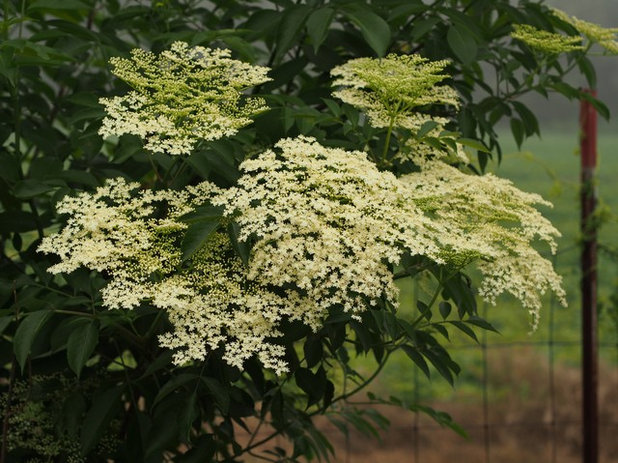 Photo by F. D. Richards
Photo by F. D. Richards
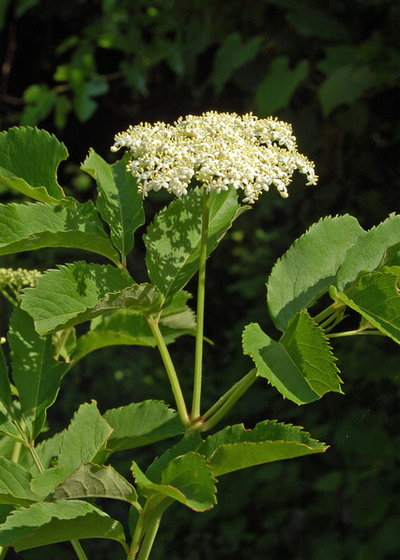
I also wanted to create edible landscapes for humans. I like the idea of being able to grab a little snack from my plants as I wander through them. While it is not recommended to eat a lot of raw elderberries, cooked elderberries are quite tasty and high in vitamin C and antioxidants. More popular in Europe, the flowers of elderberry can also be used to make teas and cordials. The flavor of the American elderberry is less intense than those from Europe. I’ve made a quick tea from my plants and would describe it as floral with a touch of honey.
Botanical names: Sambucus nigra ssp.
canadensis (previously
Sambucus canadensis)
Common names: Common elderberry, American black elderberry, American elder, black elder, Mexican elderberry, American elderberry
Origin: The entire East Coast of the U.S., spreading to the west as far as Nebraska and East Texas
Typical plant communities: Habitats range from bogs and marshes to old fields, fencerows and even into deep woods.
Where it will grow: Hardy to -40 degrees Fahrenheit (USDA zones 3 to 9; find your zone)
Water requirement: Will grow in a wide range of soil moisture, from wet to dry; prefers to grow in moist places
Light requirement: Grows quickly and blooms prolifically on sunny, moist sites; tolerates shade, but growth will be less robust
Mature size: 5 to 12 feet tall and wide, depending on conditions; longer branches will arch over at the top; mature plants will send up additional stems from the base, forming a dense thicket
Benefits and tolerances: Prolific production of purple-black berries in late summer that are a high-quality food for birds and humans alike; for human consumption, the berries should be cooked first to remove some bitter components
Shown: One flower cluster has just opened on this shrub, and a second is a couple of days away.
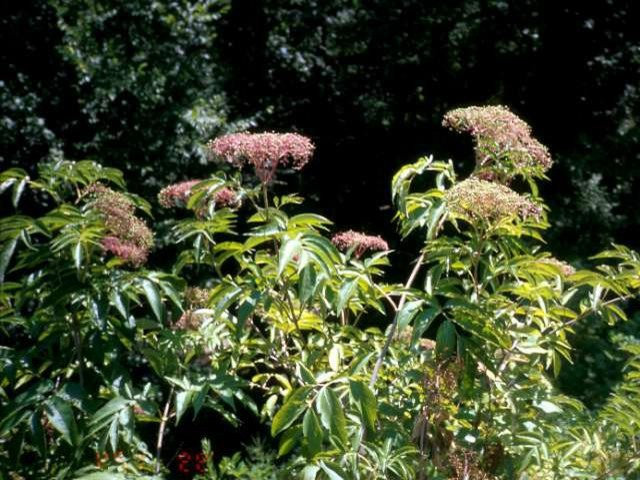
Missouri Botanical Garden
Seasonal interest: The shrub begins leafing out in early spring and will quickly send up new canes. The individual flowers are white, five-petaled stars, about ¼ inch across. They are associated in large flat-topped to slightly dome-shaped clusters, 6 to 10 inches across. The flowers open in late spring, and blooming continues for three to four weeks. As the flowers mature, the flower stems (pedicels) take on a reddish color. The flowers on my plants have a sweet, soapy scent. Others describe the scent as being sweet and musky or metallic. I don’t know if it is really that variable or if it depends on who’s doing the smelling.
When to plant: Container plants can be planted anytime from spring to fall as long as sufficient moisture is provided as the plant settles in; the shallow root system allows for relatively easy transplanting.
Shown: Here you can see how the entire flower cluster takes on a reddish color as the berries begin to ripen.
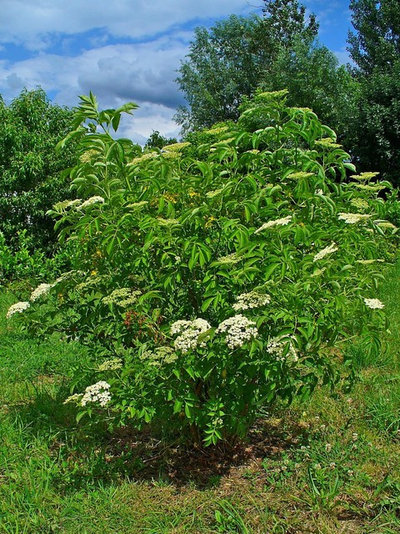 Distinguishing traits.
Distinguishing traits. Common elderberry is an upright shrub, with a dense mass of coarsely textured foliage from early spring to midfall. The leaves are pinnate, typically with five to seven leaflets. It comes into bloom in late spring, with small white flowers in 6- to 10-inch-wide clusters.
Its suckering habit makes it a good choice for a naturalistic privacy hedge. The root system is shallow and fibrous, so it is a good holding soil against erosion. While it prefers moist soils, elderberry tolerates droughty conditions well. It also tolerates a range of soil pHs, from slightly acidic to slightly alkaline. It will grow well in a range of soils from clay to sand.
Deer browsing is limited when new leaves containing some toxic substances emerge. These chemicals dissipate in late summer and fall, and deer are known to feed on the foliage. I surrounded my new plants with chicken wire to minimize deer browsing. Once the plants are well established, I will pull the protection away.
Shown: Typical appearance of common elderberry
Photo by H. Zell
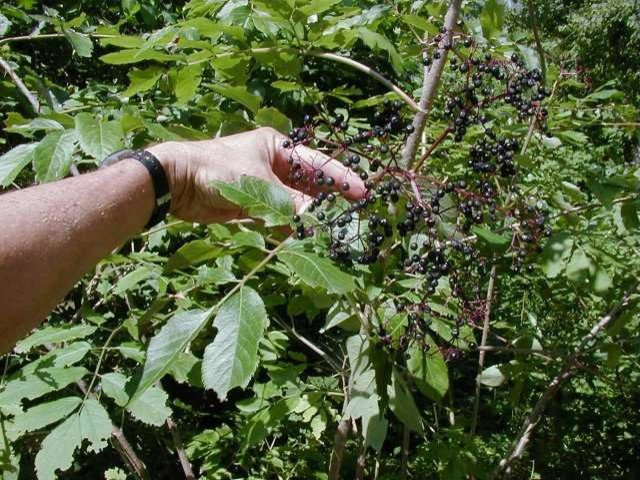
Missouri Botanical Garden
Deep purple to black ¼-inch berries ripen in late August. The berries can be used to make jellies or pies, or can be fermented into wine, if you can harvest some before hungry birds eat them all. Raw berries contain some bitter, toxic alkaloids that are destroyed in cooking, rendering the fruit sweet and safe to eat. The fruit color distinguishes it from two other North American species: red elderberry (
S. racemosa) and blue elderberry (
S. nigra ssp
caerulea).
Shown: Here you can see the ripened berries and the reddish pedicels.
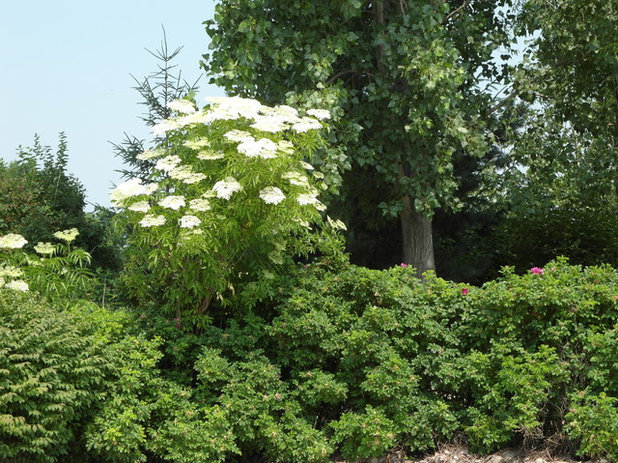 How to use it.
How to use it. Elderberry has a tendency to sucker and form dense masses, so it is better used in an informal or naturalistic setting. It could be used in a deciduous privacy screen, since the foliage density is high. It’s high wildlife value would make it an asset in a mixed hedgerow. Also the shallow root system helps stabilize slopes and stream banks against erosion.
Planting notes. The shallow root system allows for easy transplanting. Plants are available from native plant nurseries and online. Many of the cultivars may be found in larger retail nurseries. Nurseries specializing in fruit-bearing plants may have several of the large berry-producing types, such as ‘Adams’ and ‘York’. Since this plant ranges from Florida to Canada, source plants from growers that are close to your planting zone to ensure that they are adapted to your climate.
New plants grow easily from seed, after a period of overwintering on the ground. You often see elderberry growing under trees or wires where birds congregate and drop seeds.
Old and overgrown plants can be cut down close to the ground and will resprout from the roots. The best flower production is from two-year old stems. Removing wood that is more than three years old will result in better blooms on the shrub.
Photo by F. D. Richards
 Pollinator notes.
Pollinator notes. The flowers themselves do not produce nectar, so insect visitors seek the pollen. These include honey bees and a variety of native bees and flies. Nectar, however, is generated in extrafloral nectaries located near the stipules, where the leaf joins the stem. These nectaries attract beneficial insects like ladybugs and ants. Birds that feed on the berries include eastern bluebirds, northern cardinals and cedar waxwings.
Photo by rockerBOO
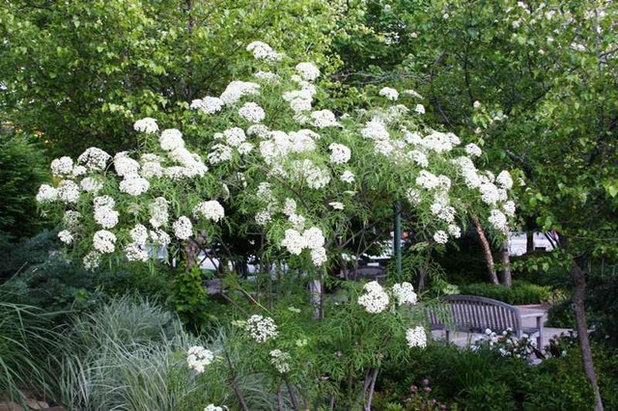
Missouri Botanical Garden
There are several cultivars of common elderberry. Two of these with improved berry production are named ‘Adams’ and ‘York’. The ‘Maxima’ cultivar has larger flower clusters than the species. The cultivars named ‘Acutiloba’ or ‘Laciniata’ have finely divided foliage, giving the plant a more delicate appearance. There is also a selection with yellow-tinged leaves named ‘Aurea’.
The European elder (
S. nigra ssp
. nigra) grows larger as a multistemmed shrub or small tree, 10 to 20 feet tall. One of the differences is that its leaflets are more elliptically shaped, while the North American species has more rounded leaflets. There are cultivars of these two species that share the same names, such as ‘Aurea’ and ‘Laciniata’, so it may be difficult to tell exactly which species you are getting.
Shown here is fernleaf common elderberry, ‘Laciniata.’ This cultivar has a more open appearance and does not grow as large as the species.
More:See how to grow a western native elderberry
8 Native Shrubs for Year-Round Bird Feeding
Browse plants native to other regions of the U.S.





